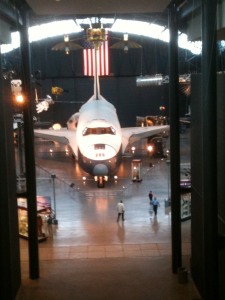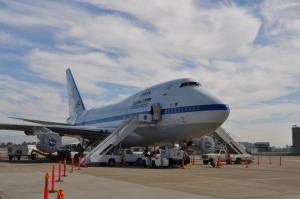Carnival of Space 220: Shuttles, satellites, comets, tweetups, competitions & more
Posted: October 23, 2011 Filed under: Uncategorized | Tags: Beyond Earth, comets, Enterprise, Eta Corvi, Jim Bean writing competition, laser, lunar base, NASA, orion, Pluto, ROSAT, scuba, shuttle, SOFIA, space debris, Spitzer, Sprite, STS127, sts135, tweetup, URAS 7 CommentsHello all and welcome to the round up of what’s been going on in the Universe this week. If you’d like to find out more, or get involved yourself, check out the Carnival’s homepage over at Universe Today.
Before we get started, an important request: Nicole at NoisyAstronomer.com is asking people to help the residents of Louisa County, Virginia, which was the epicenter of the 5.8 magnitude east cost earthquake that happened earlier this year.
Onto the stories, and let’s begin with some space-travel news. NASA Space Flight gives an update on the progress New Orleans engineers are making on the Orion Multi-Purpose Crew Vehicle. The current aim is for this vehicle to blast off into orbit in 2013, with later missions aiming for the moon and perhaps beyond.
In other NASA news, Next Big Future report on news that the Space Agency hid the cheaper cost of in-space fuel depots to get a heavy lift rocket. They also cover Robert Bigelow’s prediction that China will have claimed large parts of the moon as its territory before 2030.
If NASA’s taking too long for you, how about launching your own spacecraft? For a small donation you can, thanks to the Sprite project.
Time for some history now. Riofrio Spacetime has paid a visit to Enterprise, the test vehicle which made the Space Shuttle program possible, whilst I visited SCUBA, a groundbreaking astronomical instrument which opened up the far-infrared – a previously little-explored wavelength range. Finally Vintage Space tells the story of Apollo 10, the dress rehearsal for the moon landing, and Cheap Astro’s podcast reminisces about the STS127 shuttle mission.
There’s more distant thinking over at Universe Today, where Paul Spudis outlines his plan for an affordable lunar base. It includes a type of ‘transcontinental railroad’ which opens up cislunar space – the area between Earth and the Moon – for development.
Moving out into the Solar System, and Astroblog reports that the remnants of Comet C/2010 X1 Elenin, which disintegrated in August, have been found, whilst Dear Astronomer answers the question “Why isn’t Pluto a planet anymore?” On a related note, the Urban Astronomer writes about the swarms of comets which the Spitzer Space Telescope has detected in the solar system around the star Eta Corvi.
Next up are stories from two tweetups (an informal meeting of people brought together via twitter) that took place recently. Weather Chat and Galileo’s Pendulum share their experiences of meeting astronauts from the final shuttle flight at the STS 135 tweetup in Washington DC. There are some more photos of the event from NASA HQ here. Meanwhile open.NASA and Ian Kluft visited NASA Ames for a tweetup in honour of the Stratospheric Observatory for Infrared Astronomy, or SOFIA (or the aeroplane with a telescope in the back, that flies even though there’s a giant hole cut in the side, as I like to call it). Again, there’s more photos of the event here (including the one above) and here, as well as two videos from the day.
The re-entry of the ROSAT and UARS satellites recently has highlighted the growing problem of space debris. The Space Review revisits the legal implications of potential damage caused by this junk whilst I’ve been learning how lasers might provide the answer. For lots more information on this subject check out the new edition of The Orbital Debris Newsletter.
Nearly done now (it’s certainly been a busy astro-week!) Alice of Alice’s AstroInfo found a star in 2000 and last week it (may have) exploded. She talks about the thrill of discovery, and what the new X-ray observations might mean. Over at the Chandra Blog Jessica Brodsky has been sleuthing through the Chandra archives on a quest to tag the images.
Finally, if these stories have inspired you, here’s two competitions to get your imaginations going. The 2012 Jim Bean Memorial Writing Contest is looking for “science fiction writers who create positive stories about man’s future in space”. No pulp fiction about large-breasted alien ladies in distant galaxies please! If film’s more your thing enter the American Museum of Natural History’s Beyond Planet Earth contest. They’re looking for original, out-of-this-world ideas on the future of space exploration in 3 minutes or less – watch their introductory video to find out more:
Shrinking stars
Posted: June 10, 2009 Filed under: Uncategorized | Tags: betelgeuse, orion, supernova Leave a comment[tweetmeme only_single=false service=”wp.me” source=”allinthegutter”]
Betelgeuse is one of the brightest stars in the constellation of Orion. Its name apparently translates as the “Warrior’s Armpit” which pretty accurately describes its location! It is a red supergiant star which basically means that it is very large (about 20 times bigger than the sun), short lived and nearing the end of its life. Stars of this type die in a spectacular explosion known as a supernova, following a massive internal collapse.
New results presented this week at a conference in America suggest that since 1993 Betelgeuse has shrunk in size by around 15%, which could be a sign that this explosion is imminent. Of course, this is not the only possible explanation for the difference – it could be an illusion caused by the star’s bumpy surface (which can make it look smaller from certain angles) or it could just be a long term wobble, and it will eventually grow again. I know this is all very vague but the thought that it might explode within my lifetime is really exciting – it’s likely to be so bright that it’ll even be visible in the daytime sky for several months.
Conferences always throw up interesting stories like this that get picked up by the press. Unfortunately, this result is being overshadowed in the UK by this story (though I think this may be because of the accompanying animation and ‘end of the world’ overtones). Personally, I think the possibility that we might get to see a supernova in action close up is definitely more interesting. I’ll certainly be looking out for it!



